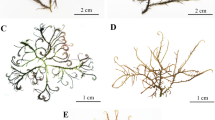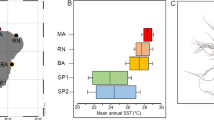Abstract
The red algal genus Asparagopsis (Bonnemaisoniaceae) is a significant resource for bioactive natural products. However, prior to domestication for commercial production, we need to understand the potential variation in growth and concentration of natural products between isolates of Asparagopsis and, beyond that, how these traits are affected by environmental conditions. Ten isolates of Asparagopsis taxiformis were collected from tropical and warm-temperate regions in Queensland, Australia, and identified by molecular barcoding of the mitochondrial intergenic spacer (cox2–3 spacer). The isolates were cultured at three temperatures ranging from the minimum of the warm-temperate region to the maximum of the tropical region. Growth rates and the concentration of natural products varied between the region of origin, between isolates within region and between temperatures. Growth differed by up to 50% between isolates, whereas the concentration of natural products differed more than tenfold. Growth rates were highest at the minimum temperature of 20.2°C, irrespective of region of origin, and were lowest at the maximum temperature of 28.1°C. Natural products were threefold higher in tropical isolates, and this variation was not correlated to growth. Consequently, targeting isolates with high concentrations of natural products should be the primary strategy for the domestication of Asparagopsis for biotechnology applications.





Similar content being viewed by others
References
Anderson M, Gorley RN, Clarke RK (2008) Permanova + for Primer: Guide to Software and Statisticl Methods
Andreakis N, Procaccini G, Kooistra WHCF (2004) Asparagopsis taxiformis and Asparagopsis armata (Bonnemaisoniales, Rhodophyta): genetic and morphological identification of Mediterranean populations. Eur J Phycol 39:273–283
Andreakis N, Procaccini G, Maggs C, Kooistra WHCF (2007) Phylogeography of the invasive seaweed Asparagopsis (Bonnemaisoniales, Rhodophyta) reveals cryptic diversity. Molec Ecol 16:2285–2299
Andreakis N, Costello P, Zanolla M, Saunders GW, Mata L (2016) Endemic or introduced? Phylogeography of Asparagopsis (Florideophyceae) in Australia reveals multiple introductions and a new mitochondrial lineage. J Phycol 52:141–147
Blanchette C, Miner B, Gaines S (2002) Geographic variability in form, size and survival of Egregia menziesii around Point Conception, California. Mar Ecol Prog Ser 239:69–82
Burreson BJ, Moore RE, Roller PP (1976) Volatile halogen compounds in the alga Asparagopsis taxiformis (Rhodophyta). J Agric Food Chem 24:856–861
Campbell AH, Harder T, Nielsen S, Kjelleberg S, Steinberg PD (2011) Climate change and disease: bleaching of a chemically defended seaweed. Glob Chang Biol 17:2958–2970
Cronin G, Hay ME (1996) Effects of light and nutrient availability on the growth, secondary chemistry, and resistance to herbivory of two brown seaweeds. Oikos 77:93–106
Darriba D, Taboada GL, Doallo R, Posada D (2012) jModelTest 2: more models, new heuristics and parallel computing. Nat Meth 9:772–772
Dijoux L, Viard F, Payri C (2014) The more we search, the more we find: discovery of a new lineage and a new species complex in the genus Asparagopsis. PLoS One 9(7):e103826
Eggert A (2012) Seaweed responses to temperature. In: Wiencke C, Bischof K (eds) Seaweed Biology. Springer, Berlin, pp. 47–66
El-Baroty G, Moussa M, Shallan M, Ali M, Sabh A, Shalaby E (2007) Contribution to the aroma, biological activities, minerals, protein, pigments and lipid contents of the red alga: Asparagopsis taxiformis (Delile) Trevisan. J Appl Sci Res 3:1825–1834
Felsenstein J (1985) Confidence intervals on phylogenies: an approach using the bootstrap. Evolution 39:783–791
Fowler-Walker MJ, Wernberg T, Connell SD (2006) Differences in kelp morphology between wave sheltered and exposed localities: morphologically plastic or fixed traits? Mar Biol 148:755–767
Goldman JC, Ryther JH, Williams LD (1975) Mass production of marine algae in outdoor cultures. Nature 254:594–595
Greff S, Zubia M, Genta-Jouve G, Massi L, Perez T, Thomas OP (2014) Mahorones, highly brominated cyclopentenones from the red alga Asparagopsis taxiformis. Journal of Nat Prod 77:1150–1155
Guillard RRL (1975) Culture of phytoplankton for feeding marine invertebrates. In: Smith WL, Chanley MH (eds) Culture of marine invertebrate animals. Plenum Press, New York, pp. 29–60
Guiry M, Guiry G (2011) AlgaeBase. 2011. World-wide electronic publication. National University of Ireland, Galway
Gupta V, Bijo AJ, Kumar M, Reddy CRK, Jha B (2012) Detection of epigenetic variations in the protoplast-derived germlings of Ulva reticulata using methylation sensitive amplification polymorphism (MSAP). Mar Biotech 14:692–700
Hall TA (1999) BioEdit: a user-friendly biological sequence alignment editor and analysis program for Windows 95/98/NT. Nucleic Acids Symposium 41:95–98
Hutson KS, Mata L, Paul NA, de Nys R (2012) Seaweed extracts as a natural control against the monogenean ectoparasite, Neobenedenia sp., infecting farmed barramundi (Lates calcarifer). Int J Parasitol 42:1135–1141
Keinänen M, Oldham NJ, Baldwin IT (2001) Rapid HPLC screening of jasmonate-induced increases in tobacco alkaloids, phenolics, and diterpene glycosides in Nicotiana attenuata. J Ag Food Chem 49:3553–3558
Kraan S, Barrington K (2005) Commercial farming of Asparagopsis armata (Bonnemaisoniceae, Rhodophyta) in Ireland, maintenance of an introduced species? J Appl Phycol 17:103–110
Kumar M, Bijo AJ, Baghel RS, Reddy CRK, Jha B (2012) Selenium and spermine alleviate cadmium induced toxicity in the red seaweed Gracilaria dura by regulating antioxidants and DNA methylation. Plant Physiol Biochem 51:129–138
Lawton RJ, Mata L, de Nys R, Paul NA (2013) Algal bioremediation of waste waters from land-based aquaculture using Ulva: selecting target species and strains. PLoS One 8(10):e77344
Machado L, Magnusson M, Paul NA, de Nys R, Tomkins N (2014) Effects of marine and freshwater macroalgae on in vitro total gas and methane production. PLoS One 9(1):e85289
Mata L, Schuenhoff A, Santos R (2010) A direct comparison of the performance of the seaweed biofilters, Asparagopsis armata and Ulva rigida. J Appl Phycol 22:639–644
Mata L, Gaspar H, Justino F, Santos R (2011) Effects of hydrogen peroxide on the content of major volatile halogenated compounds in the red alga Asparagopsis taxiformis (Bonnemaisoniaceae). J Appl Phycol 23:827–832
Mata L, Gaspar H, Santos R (2012) Carbon/nutrient balance in relation to biomass production and halogenated compound content in the red alga Asparagopsis taxiformis (Bonnemaisoniaceae). J Phycol 48:248–253
Mata L, Wright E, Owens L, Paul N, de Nys R (2013) Water-soluble natural products from seaweed have limited potential in controlling bacterial pathogens in fish aquaculture. J Appl Phycol 25:1963–1973
Mata L, Magnusson M, Paul N, de Nys R (2016) The intensive land-based production of the green seaweeds Derbesia tenuissima and Ulva ohnoi: biomass and bioproducts. J Appl Phycol 28:365–375
Matlock D, Ginsburg D, Paul V (1999) Spatial variability in secondary metabolite production by the tropical red alga Portieria hornemannii. In: Kain J, Brown M, Lahaye M (eds) Sixteenth International Seaweed Symposium. Springer, Netherlands, pp. 267–273
McConnell O, Fenical W (1977) Halogen chemistry of the red alga Asparagopsis. Phytochemistry 16:367–374
Moigne J (1998) Use of algae extracts as antibacterial and/or antifungal agent and composition containing same. PCT Patent Appl WO 1998010656:A1
Monro K, Poore AG (2004) Selection in modular organisms: is intraclonal variation in macroalgae evolutionarily important? Am Nat 163:564–578
Neveux N, Magnusson M, Maschmeyer T, de Nys R, Paul NA (2014) Comparing the potential production and value of high-energy liquid fuels and protein from marine and freshwater macroalgae. GCB Bioenergy 7:673–689
Oliveira AS, Sudatti DB, Fujii MT, Rodrigues SV, Pereira RC (2013) Inter- and intrapopulation variation in the defensive chemistry of the red seaweed Laurencia dendroidea (Ceramiales, Rhodophyta). Phycologia 52:130–136
Padilla-Gamino JL, Carpenter RC (2007) Seasonal acclimatization of Asparagopsis taxiformis (Rhodophyta) from different biogeographic regions. Limnol Oceanogr 52:833–842
Park JBK, Craggs RJ, Shilton AN (2011) Wastewater treatment high rate algal ponds for biofuel production. Bioresource Technol 102:35–42
Paul NA, de Nys R, Steinberg PD (2006) Chemical defence against bacteria in the red alga Asparagopsis armata: linking structure with function. Mar Ecol Prog Ser 306:87–101
Paul NA, Svensson CJ, de Nys R, Steinberg PD (2014) Simple growth patterns can create complex trajectories for the ontogeny of constitutive chemical defences in seaweeds. PLoS One 9(1):e86893
Pavia H, Åberg P (1996) Spatial variation in polyphenolic content of Ascophyllum nodosum (Fucales, Phaeophyta). In: Lindstrom S, Chapman D (eds) Fifteenth International Seaweed Symposium. Springer, Netherlands, pp. 199–203
Schneider CA, Rasband WS, Eliceiri KW, Schindelin J, Arganda-Carreras I, Frise E, Kaynig V, Longair M, Pietzsch T, Preibisch S (2012) 671 NIH image to imageJ: 25 years of image analysis. Nat Meth 9:671–675
Schuenhoff A, Mata L, Santos R (2006) The tetrasporophyte of Asparagopsis armata as a novel seaweed biofilter. Aquaculture 252:3–11
Swofford DL (2002) PAUP*. Phylogenetic analysis using parsimony (*and other methods). Version 4. Sinauer Associates, Sunderland
Wood JM, Kennedy FS, Wolfe RS (1968) Reaction of multihalogenated hydrocarbons with free and bound reduced vitamin B12. Biochemistry 7:1707–1713
Woolard FX, Moore RE, Roller PP (1976) Halogenated acetamides, but-3-en-2-ols, and isopropanols from Asparagopsis taxiformis (Delile) Trev. Tetrahedron 32:2843–2846
Woolard FX, Moore RE, Roller PP (1979) Halogenated acetic and acrylic acids from the red alga Asparagopsis taxiformis. Phytochemistry 18:617–620
Wright JT, de Nys R, Steinberg PD (2000) Geographic variation in halogenated furanones from the red alga Delisea pulchra and associated herbivores and epiphytes. Mar Ecol Prog Ser 207:227–241
Zambounis A, Strittmatter M, Gachon CMM (2013) Chronic stress and disease resistance in the genome model marine seaweed Ectocarpus siliculosus. Aquat Bot 104:147–152
Zanolla M, Carmona R, De la Rosa J, Salvador N, Sherwood AR, Andreakis N, Altamirano M (2014) Morphological differentiation of cryptic lineages within the invasive genus Asparagopsis (Bonnemaisoniales, Rhodophyta). Phycologia 53:233–242
Zanolla M, Altamirano M, Carmona R, De La Rosa J, Sherwood A, Andreakis N (2015) Photosynthetic plasticity of the genus Asparagopsis (Bonnemaisoniales, Rhodophyta) in response to temperature: implications for invasiveness. Biol Invas 17:1341–1353
Zuccarello G, Burger G, West J, King R (1999) A mitochondrial marker for red algal intraspecific relationships. Molec Ecol 8:1443–1447
Acknowledgments
This research is part of the MBD Energy Research and Development program. We thank Boer Bao, Maria Martinez and Katherine Darlington for assistance with experiments and Veronique Mocellin for assistance with the chemical analysis. NA was funded through the National Environmental Research Program (NERP), an Australian Government initiative.
Author information
Authors and Affiliations
Corresponding author
Rights and permissions
About this article
Cite this article
Mata, L., Lawton, R.J., Magnusson, M. et al. Within-species and temperature-related variation in the growth and natural products of the red alga Asparagopsis taxiformis . J Appl Phycol 29, 1437–1447 (2017). https://doi.org/10.1007/s10811-016-1017-y
Received:
Revised:
Accepted:
Published:
Issue Date:
DOI: https://doi.org/10.1007/s10811-016-1017-y




